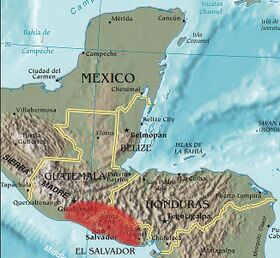Earth:Tierra Blanca Joven eruption
| Tierra Blanca Joven eruption | |
|---|---|
 The eruption created an 8 by 11 km (5.0 by 6.8 mi) lake-filled caldera known as Lake Ilopango. | |
| Volcano | Lake Ilopango |
| Type | Ultra-Plinian |
| Location | El Salvador, Central America [ ⚑ ] 13°40′N 89°03′W / 13.67°N 89.05°W |
| VEI | 6 |
 The estimated ashfall in the region during the Tierra Blanca Joven eruption. The ash covered at least 10,000 km2 (3,900 sq mi) up to 50 cm (20 in) deep,[1] and nearly 2,000,000 km2 (770,000 sq mi) with a blanket at least 0.5 cm (0.20 in) in depth.[2] The red spot is the ash at the bottom of the image. | |
The Tierra Blanca Joven eruption of Lake Ilopango was the largest volcanic eruption in El Salvador during historic times, and one of the largest volcanic events on Earth in the past 7,000 years, registering at 6 on the Volcanic explosivity index (VEI), and dating back to the mid 5th century A.D. The eruption produced between 37–82 km3 (8.9–19.7 cu mi) of ejecta (dense-rock equivalent).[2][3][4] The date of the eruption has been constrained within 429–433 CE by identifying its signature volcanic ash in precision-dated ice cores sampled from Greenland, thus eliminating it as the cause of extreme weather events of 535–536.[2]
Volcanic eruption
The Tierra Blanca Joven eruption is El Salvador's largest volcanic eruption in the last 10,000 years. This VEI-6 Plinian eruption occurred during the 5th century and was larger than the 1883 eruption of Krakatoa or the 1991 eruption of Mount Pinatubo, having probably been more comparable to the 1815 eruption of Mount Tambora.[5] It produced about 104–207 km3 (25–50 cu mi) of tephra (several times as much as the 1980 eruption of Mount St. Helens), produced major pyroclastic fall and large pyroclastic flows that covered 10,000 km2 (3,900 sq mi) with over 50 cm (20 in) of pumice and ash,[1] and nearly 2,000,000 km2 (770,000 sq mi) with a blanket of ash at least 0.5 cm (0.20 in) in depth.[2] The eruption devastated an area of up to 100 km (62 mi) radius around the volcano. Having produced 37–82 km3 (8.9–19.7 cu mi) (dense-rock equivalent) of volcanic products,[4] the Tierra Blanca Joven eruption is one of the largest volcanic events on Earth in recorded history.[6]
See also
- 1257 Samalas eruption
- 1815 eruption of Mount Tambora
- List of large Holocene volcanic eruptions
- Volcanic winter
- Year Without a Summer
References
- ↑ 1.0 1.1 Dull, Robert A.; Southon, John R.; Sheets, Payson (2001). "Volcanism, Ecology and Culture: A Reassessment of the Volcán Ilopango TBJ eruption in the Southern Maya Realm". Late Antiquity (Society for American Archaeology) 12 (1): 25–44. doi:10.2307/971755. https://www.cambridge.org/core/journals/latin-american-antiquity/article/abs/volcanism-ecology-and-culture-a-reassessment-of-the-volcan-ilopango-tbj-eruption-in-the-southern-maya-realm/58C3880AA271883275524575BC1AF1D1. Retrieved 2023-12-29.
- ↑ 2.0 2.1 2.2 2.3 Smith, Victoria C.; Costa, Antonio; Aguirre-Díaz, Gerardo; Pedrazzi, Dario; Scifo, Andrea; Plunkett, Gill; Poret, Mattieu; Tournigand, Pierre-Yves et al. (2020-10-20). "The magnitude and impact of the 431 CE Tierra Blanca Joven eruption of Ilopango, El Salvador" (in en). Proceedings of the National Academy of Sciences 117 (42): 26061–26068. doi:10.1073/pnas.2003008117. ISSN 0027-8424. PMID 32989145. Bibcode: 2020PNAS..11726061S.
- ↑ Dull, Robert A.; Southon, John R.; Kutterolf, Steffen; Anchukaitis, Kevin J.; Freundt, Armin; Wahl, David B.; Sheets, Payson; Amaroli, Paul et al. (2019). "Radiocarbon and geologic evidence reveal Ilopango volcano as source of the colossal 'mystery' eruption of 539/40 CE" (in en). Quaternary Science Reviews 222: 105855. doi:10.1016/j.quascirev.2019.07.037. ISSN 0277-3791. Bibcode: 2019QSRv..22205855D.
- ↑ 4.0 4.1 Jicha, Brian R; Hernández, Walter (January 2022). "Effusive and explosive eruptive history of the Ilopango caldera complex, El Salvador". Journal of Volcanology and Geothermal Research (Elsevier) 421 (107426). doi:10.1016/j.jvolgeores.2021.107426. https://www.sciencedirect.com/science/article/abs/pii/S0377027321002559. Retrieved 2023-12-29.
- ↑ "Ilopango". https://www.volcanodiscovery.com/ilopango.html.
- ↑ Colossal volcano behind 'mystery' global cooling finally found. National Geographic. 23 August 2019.
External links
- Global Volcanism Program: Ilopango
- Lake Ilopango at NASA Earth Observatory website
- Volcano Discovery: Ilopango
 |

